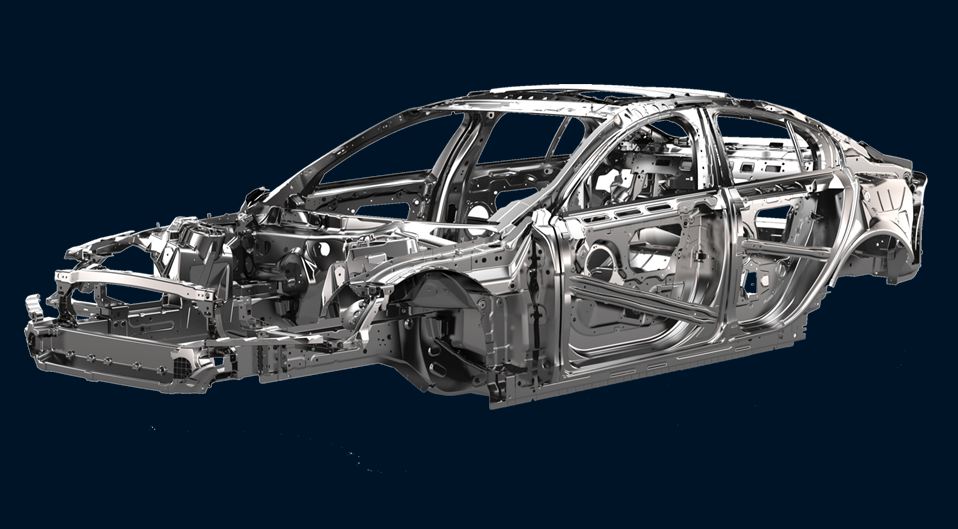Automotive Aluminum in Cars & Trucks

From mass-market vehicles like the Ford F-150 to luxury cars like Audi, Mercedes Benz and Land Rover, aluminum is increasingly the “material of choice” for automakers thanks to its strength and environmental advantages. The Aluminum Association’s Aluminum Transportation Group (ATG) communicates the benefits of aluminum in transportation through research programs and related outreach activities.
Take-Away Facts
- Continuous growth in automotive use
The use of automotive aluminum has grown continuously for 40 years. Aluminum is now second only to steel as the most used material in vehicles. - Recycled at record levels
At the end of a vehicle’s life, nearly 90 percent of the aluminum, on average, is recycled. - Energy efficiency
Compared with a fleet of traditional steel vehicles, aluminum use saves the equivalent of 108 million barrels of crude oil in energy. - Safer
Pound for pound, aluminum can absorb twice the crash energy of mild steel. Larger crush zones can be designed without corresponding weight penalties.
Performance benefits
Because aluminum is lighter, it allows automakers to increase dent resistance - they can make body panels thicker while still lowering weight. And a lower weight vehicle has better acceleration, better braking and better handling. In addition, lighter vehicles can haul and tow more because the engine isn’t carrying unneeded weight.
Weight, strength and safety benefits
When applied to an optimized automotive body structure, aluminum can provide a weight savings of up to 50 percent compared with the traditional mild steel structure. Aluminum body structures are equal or superior in strength to steel and absorb twice as much crash-induced energy. Primary-structure weight savings also allow other vehicle systems to be downsized (including the engine, transmission, suspension and wheels). Across the board, in weight, strength and safety, aluminum’s advantages are clear.
Environmental benefits
Nearly 90 percent of automotive aluminum scrap - more than a half-million tons a year - is recovered and recycled. To place this in perspective: Recycling 1 ton of aluminum saves the energy equivalent of 21 barrels of oil. The environmental wins continue: A peer-reviewed study by the Department of Energy's Oak Ridge National Laboratory found that an aluminum-intensive vehicle can achieve up to a 20 percent reduction in total life cycle energy consumption and up to a 17 percent reduction in CO2 emissions.

Looking forward: The race for fuel efficiency
Increasingly, consumers are demanding more fuel-efficient vehicles. Considering this along with new fuel economy regulations that will require the U.S. vehicle fleet to average 54.5 miles per gallon by 2025, the auto industry is responding. One example: Ford’s all-aluminum-body F-150 pickup truck. This move toward aluminum has profound implications - the Ford F-150 is the most popular vehicle of any kind in the United States and one of the most profitable motor vehicle lines in the world. The 2015 F-150 truck shed 700 pounds (approximately 15 percent in vehicle body-weight) with a high-strength, military-grade all-aluminum body. This weight reduction enables Ford’s trucks to go farther on a gallon of gasoline and opens the door to other changes, like smaller engines, that can further boost fuel economy.
The history of aluminum in cars
A growth market today, aluminum has been a key material for automakers since the beginning. The first sports car featuring an aluminum body was unveiled at the Berlin International Motor Show in 1899. Two years later, the first engine with aluminum parts was developed by Carl Benz. Following World War II, aluminum had become inexpensive enough to be considered for use in mass-produced vehicles. A breakthrough occurred in 1961, when the British Land Rover company produced V-8 engine blocks made with aluminum cylinders. From there, aluminum automobile parts gained a foothold in wheels and transmission casings and then moved into cylinder heads and suspension joints. This infinitely recyclable metal is now the leading material for use in powertrain and wheel applications and continues to gain market share in hoods, trunks, doors and bumpers - and complete vehicle structures.
Cool Fact: The Clear Choice of Automakers
In 2013, Ford’s President and CEO Alan Mulally sang the praises of automotive aluminum in a number of media interviews surrounding the announcement of the new F-150 truck. Among other comments, Mulally said, “pound for pound, aluminum is stronger and tougher than steel” and “aluminum will be the material of choice” for Ford moving forward.
(According to The Aluminum Association)
KIMSEN is proud to bring high quality aluminum extrusion, components & modules which meet international standards.
For specific advice, please contact Hotline 0243 795 7410 or email info@kimsen.vn
KIMSEN INDUSTRIAL CORPORATION
Head Office & Factory: Yen Phong Industrial Park, Yen Phong Dist., Bac Ninh Pro., Vietnam
Hanoi Office: 14th floor, TTC Tower, No. 19 Duy Tan Str., Cau Giay Dist., Hanoi, Vietnam
Hotline: 0243 795 7410
Email: info@kimsen.vn
Images source: Internet
*Reference: https://www.aluminum.org/product-markets/automotive


 Chia sẻ:
Chia sẻ: